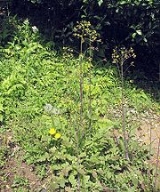
Youngia
Encyclopedia
Youngia is an Asiatic genus of Asteraceae
. There are several weed species in the genus including the endangered Youngia nilgiriensis
Babcock from Sispara
and Youngia japonica, which is also known as Japanese Hawkweed.
Youngia was first described in 1831 by H. Cassini, and the genus was later united with Crepis
. Taxomonic and cytogenetic studies by E. B. Babcock
and G. Ledyard Stebbins
led to the reclassification of the genus in the 1930s.
Asteraceae
The Asteraceae or Compositae , is an exceedingly large and widespread family of vascular plants. The group has more than 22,750 currently accepted species, spread across 1620 genera and 12 subfamilies...
. There are several weed species in the genus including the endangered Youngia nilgiriensis
Youngia nilgiriensis
Youngia nilgiriensis is an endangered perennial herb. It is endemic to the Sispara area of the Kundah range of the Nilgiri Hills, Tamil Nadu, South India characterised by vast stretches of grasslands interrupted by numerous sholas at an altitude of around . It is listed as an endangered species in...
Babcock from Sispara
Sispara
[Image:Peacocke-Travellers Bungalow, Sispara.jpg|thumb|350px|View to the west, of Sispara bungalow and Sispara peak across the stream in Sispara pass from the Sispara ghat trail...
and Youngia japonica, which is also known as Japanese Hawkweed.
Youngia was first described in 1831 by H. Cassini, and the genus was later united with Crepis
Crepis
Crepis, commonly known in some parts of the world as hawksbeard or hawk's-beard , is a genus of about 200 annual and perennial flowering plants of the family Asteraceae superficially resembling the dandelion, the most conspicuous difference being that Crepis usually has branching...
. Taxomonic and cytogenetic studies by E. B. Babcock
E. B. Babcock
Ernest Brown Babcock was an United States plant geneticist. His pioneering work on the genetics of the genus Crepis and his more than 100 published articles explaining plant evolution primarily in terms of genetics mark him as a pioneer in the application of genetics research.- References :*...
and G. Ledyard Stebbins
G. Ledyard Stebbins
George Ledyard Stebbins, Jr. was an American botanist and geneticist who is widely regarded as one of the leading evolutionary biologists of the 20th century. Stebbins received his Ph.D. in botany from Harvard University in 1931. He went on to the University of California, Berkeley, where his work...
led to the reclassification of the genus in the 1930s.

